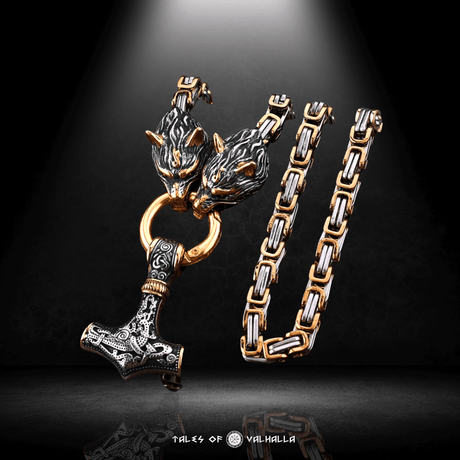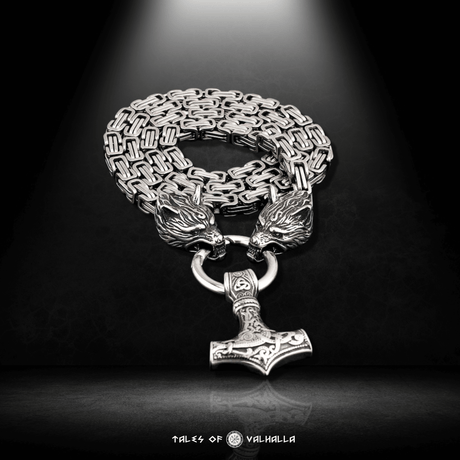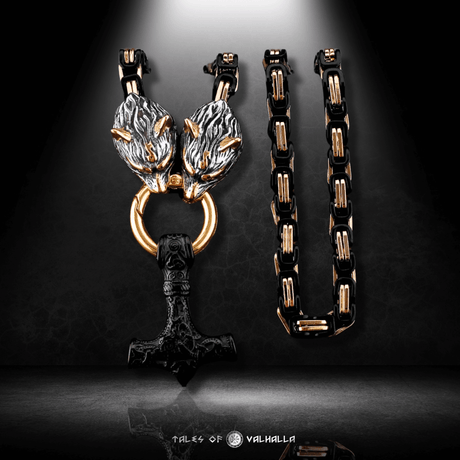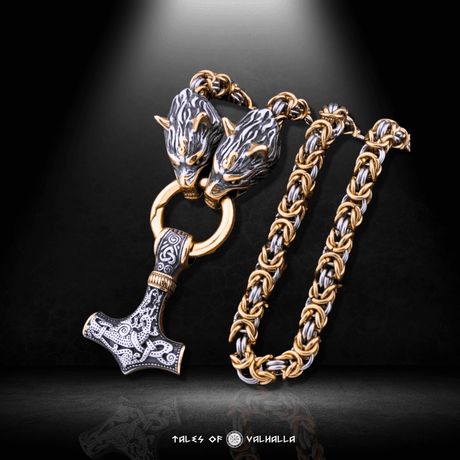In the vast and enigmatic world of Norse mythology, few figures loom as large as Odin, the Allfather, the one-eyed god of wisdom, war, and death. Revered and feared by gods and mortals alike, Odin is a complex deity who embodies the relentless pursuit of knowledge and the mysteries of life and death. But even a god as powerful as Odin does not navigate the cosmos alone. By his side, or rather, soaring above him, are two mystical ravens, Huginn and Muninn, who serve as his eyes and ears across the realms.

The Significance of Huginn and Muninn
These two ravens are not mere companions; they are extensions of Odin himself, embodying thought and memory—two fundamental aspects of his being. Huginn, whose name translates to "thought," and Muninn, meaning "memory," are tasked with flying over Midgard (the world of humans) and beyond each day, gathering information and bringing it back to their master. Through them, Odin gains insight into the happenings of the world, allowing him to maintain his status as the wisest of the gods.
Historical Background
The Origins in Norse Sagas and Eddas
The origins of Huginn and Muninn are deeply rooted in the ancient Norse sagas and the Poetic Edda, the primary sources of Norse mythology. These texts, composed in the 13th century but based on much older oral traditions, offer a glimpse into the beliefs and values of the Viking Age. In these stories, Odin is often depicted as a god who is constantly seeking wisdom, even at great personal cost.
Etymology and Name Meanings
Huginn and Muninn first appear in these texts as Odin's loyal companions, described as flying out at dawn and returning at dusk, whispering all they have seen and heard into his ear. Their names, which mean "thought" and "memory," respectively, are not chosen lightly. In the Norse understanding of the world, thought and memory are not just mental faculties but powerful forces that shape reality.
The Raven's Role in Norse Culture
The significance of ravens in Norse culture goes beyond their association with Odin. Ravens were often seen as symbols of death, war, and prophecy, which made them natural companions for a god like Odin, who presides over these domains. In the harsh and unpredictable world of the Vikings, where life was often short and violent, the raven's role as a harbinger of death and destruction was both feared and revered.
Roles and Symbolism

The Raven's Role in Norse Culture
Huginn and Muninn as Odin’s Messengers
Huginn and Muninn are not just passive observers; they play an active role in Odin's rule over the Nine Realms. As his messengers, they traverse the world each day, gathering intelligence that Odin uses to make decisions and maintain order among the gods and mortals. Their daily journey symbolizes the constant flow of information and the importance of staying informed, themes that resonate strongly with the Norse emphasis on knowledge and wisdom.
The Duality of Thought and Memory
The symbolism of Huginn and Muninn goes even deeper when we consider their names. Huginn, representing thought, is associated with the intellectual and cognitive aspects of Odin's character. Thought is the source of ideas, creativity, and problem-solving, all of which are crucial for a god who must navigate the complexities of the cosmos. Muninn, on the other hand, represents memory, which is equally vital. Memory is not just about recalling the past; it is about preserving knowledge, learning from experiences, and maintaining a connection to one's roots and identity.
Ravens as Symbols of Death and Prophecy
The raven's association with death and prophecy adds another layer of symbolism to Huginn and Muninn. Ravens are often seen as omens, birds that appear on the battlefield to feast on the dead. In this context, Huginn and Muninn can be seen as not only gatherers of information but also harbingers of fate. Their ability to see and remember all that happens gives Odin a unique advantage, allowing him to foresee and influence the outcomes of events.
Cultural Impact and Legacy
Huginn and Muninn in Literature
The legacy of Huginn and Muninn extends far beyond the Viking Age. Over the centuries, these two ravens have captured the imagination of artists, writers, and scholars, becoming enduring symbols of wisdom, knowledge, and the power of the mind. Their presence in modern pop culture is a testament to their lasting impact on our collective consciousness.
Artistic Depictions of Odin’s Ravens
In visual art, the image of Odin with his two ravens has become iconic, symbolizing the god's wisdom and his connection to the unseen world. This imagery can be found in everything from ancient carvings and paintings to modern tattoos and digital art. The raven, as a symbol, has also become synonymous with mystery and the unknown, often used to evoke a sense of foreboding or the presence of otherworldly forces.
Modern Interpretations in Music and Media
Huginn and Muninn's influence extends to the realm of music as well, with several bands and musicians drawing inspiration from Norse mythology to create songs that explore the themes of memory, thought, and the passage of time. The ravens are often portrayed as guardians of ancient wisdom, their cries echoing the stories of the past and the knowledge that has been passed down through generations.
Mythological Interpretations and Theories

Mythological Interpretations and Theories
Autonomous Beings or Extensions of Odin?
The story of Huginn and Muninn has been the subject of much interpretation and debate among scholars and enthusiasts alike. While the traditional view sees them as extensions of Odin's mind, representing thought and memory, some interpretations suggest that they may have a more complex and independent existence.
Duality in Odin’s Nature
Another intriguing interpretation is that Huginn and Muninn represent the duality of Odin's nature. As the god of wisdom and war, Odin embodies both the light and dark aspects of existence. Huginn, with his association with thought, represents the more rational and strategic side of Odin, while Muninn, tied to memory, represents the emotional and instinctual aspects. Together, they reflect the balance that Odin must maintain between his intellect and his instincts, a balance that is crucial for his role as the ruler of the gods.
Cross-Cultural Comparisons
Some scholars have also drawn parallels between Huginn and Muninn and other mythological creatures from different cultures. For example, the concept of birds as messengers of the gods is not unique to Norse mythology and can be found in various other traditions, such as the Greek Harpies or the Egyptian Bennu bird. These comparisons suggest that the story of Huginn and Muninn may be part of a broader mythological theme, where birds serve as intermediaries between the divine and mortal realms.
Conclusion
The story of Huginn and Muninn is a powerful reminder of the importance of thought and memory in our lives. As Odin's messengers, they represent the dual forces that shape our understanding of the world and our place within it. Through them, Odin gains the knowledge and wisdom that make him the Allfather, the ruler of gods and men.
But Huginn and Muninn are more than just mythological figures; they are symbols of the human experience. Thought and memory are what define us as individuals and as a society. They are the tools we use to navigate the complexities of life, to learn from the past, and to shape the future. In this sense, Huginn and Muninn are not just Odin's ravens; they are reflections of ourselves.






























































































